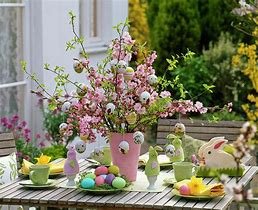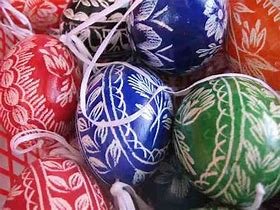
Oke, ini contohnya:
The tradition of decorating eggs in Austria, known as “Ostereier” (Easter eggs), has been practiced for centuries. These intricately crafted eggs are not merely decorative ornaments, but they embody the spirit of Easter, a time of renewal and joy.
While painted eggs can be found in many cultures across the globe, Austria boasts a unique style characterized by meticulous craftsmanship & delicate designs. Often, these eggs are painted in vibrant hues & adorned with intricate patterns of floral motifs, landscapes, or even biblical scenes.
Traditional Ostereier were often painstakingly crafted using natural dyes from plants and flowers, contributing to the exquisite richness of colors & the inherent charm of each egg. Today, the art of Ostereier continues to thrive. Modern artists use a broader palette of colors, incorporating contemporary themes and techniques while maintaining the respect for traditional methods.
This dedication to intricate detail sets Austrian eggs apart. From the carefully chosen color palette to the precise application of wax or paint, the artist’s dedication to perfection is readily apparent in each finished piece. The finished product is not merely an egg but a miniature artwork, a testament to the creativity & cultural heritage of the Austrian people.
Related Post : aspen home decorative blanket
More than just a pretty decoration, Ostereier hold a special place in Austrian culture. These decorated eggs serve as gifts, tokens of love, & symbols of hope. Their creation & exchange bind families & communities together, perpetuating the rich tradition through the generations. For tourists & collectors alike, the art of Ostereier offers a window into Austrian craftsmanship, a vibrant expression of the nation’s artistry and cultural identity.
Austrian Decorated Eggs: A Celebration of Folk Art and Tradition
Austria is renowned for its rich cultural heritage, and one of its most captivating expressions is the art of decorating eggs. These intricately adorned eggs, known as “Ostereier,” are more than just Easter decorations; they are vibrant testaments to centuries of tradition, artistic skill, and cultural identity.
What are Austrian Decorated Eggs?
Austrian decorated eggs are a unique form of folk art, encompassing a wide scope of techniques and styles. From simple, hand-painted designs to elaborate, three-dimensional masterpieces, these eggs represent a fusion of tradition and creativity. They are often seen as symbols of life, renewal, and the arrival of spring, making them a central part of Easter celebrations in Austria.
A Brief History of the Tradition: Tracing the roots of this unique art form.
The practice of decorating eggs dates back centuries, with evidence suggesting that ancient civilizations around the world used eggs as decorative and symbolic objects. In Austria, the tradition of egg decorating is deeply rooted in folklore and religious beliefs.
Early forms of egg decorating involved simple techniques like scratching designs into the eggshell or using natural dyes derived from plants and minerals. Over time, these techniques evolved into more elaborate and intricate methods, reflecting the changing artistic tastes and cultural influences of the times.
The Significance of Eggs in Austrian Culture: Understanding the symbolic meaning of eggs in Austrian traditions.
Eggs have held a special significance in Austrian culture for centuries. They symbolize new beginnings, fertility, and the cycle of life and death. In the context of Easter, eggs represent the resurrection of Christ and the promise of new life.
This symbolism is reflected in the colors and motifs used in Austrian egg decorations. For example, the color red is often associated with blood and sacrifice, while green symbolizes hope and renewal.
From Simple to Elaborate: Exploring the evolution of Austrian egg decorating techniques.
The evolution of Austrian egg decorating techniques reflects the changing artistic sensibilities and technological advancements throughout history. Early methods, such as scratching and dyeing, gave way to more intricate techniques like wax resist, decoupage, and the use of specialized tools for creating detailed patterns.
These advancements allowed artists to express their creativity with greater precision and detail, leading to the development of diverse and unique styles of egg decoration.
The Art of Egg Decorating: Techniques and Materials
The beauty of Austrian decorated eggs lies in the artistry and craftsmanship that goes into their creation. These intricate designs are often created using a combination of traditional and modern techniques, each contributing to the unique character of the final product.
Traditional Techniques: A look at the most common and historic methods used in Austrian egg decorating.
- Scratching: This involves scratching designs into the eggshell using a sharp object, such as a needle or a piece of metal. The scratched areas are then exposed, creating a contrast against the surrounding shell.
- Dyeing: Natural dyes derived from plants and minerals were traditionally used to color eggs. Common examples include beetroot for red, onion skins for yellow, and walnut husks for brown.
- Wax Resist: This technique involves applying melted wax to the eggshell, creating a barrier that prevents the dye from penetrating those areas. Once the dye is applied, the wax is removed, revealing the uncolored areas and creating intricate patterns.
Modern Techniques: How contemporary artists are pushing the boundaries of this art form.
While traditional techniques continue to be practiced, contemporary artists are exploring new ways to enhance and elevate the art of egg decorating. Modern techniques include:
- Decoupage: This involves adhering paper cutouts or fabric scraps to the eggshell to create decorative designs.
- Embellishment: Beads, sequins, and other embellishments are often used to add extra sparkle and texture to egg decorations.
- 3D Design: Artists are experimenting with creating intricate three-dimensional designs on eggshells, using techniques such as paper mache and sculpting.
Materials Used: Exploring the various materials employed in egg decorating, from natural dyes to modern paints.
The materials used in egg decorating have evolved over time, reflecting technological advancements and artistic preferences.
- Natural Dyes: Natural dyes continue to be used by traditional artists and those seeking a more authentic approach.
- Synthetic Dyes: Modern artists often employ a wider scope of synthetic dyes to achieve specific colors and shades.
- Paints: Acrylic and oil paints are commonly used for creating detailed designs and embellishments.
- Other Materials: Beads, glitter, sequins, feathers, and various found objects are used to add texture, sparkle, and dimension to egg decorations.
Exploring varied Styles of Austrian Decorated Eggs
The diversity of Austrian egg decorating styles reflects the country’s rich cultural heritage and the artistic creativity of its people.
The "Ostereier" (Easter Eggs): A look at the traditional decorations used for Easter eggs in Austria.
“Ostereier” are Easter eggs that are decorated with traditional motifs and colors. These decorations often include symbolic elements like flowers, hearts, crosses, and animals, representing themes of renewal, fertility, and the arrival of spring.
The "Trachteneier" (Folk Costume Eggs): Discovering the art of eggs decorated with traditional Austrian folk costumes.
“Trachteneier” are eggs that are decorated with intricate designs inspired by traditional Austrian folk costumes. These costumes are often characterized by colorful patterns, intricate embroidery, and elaborate headwear, which are beautifully reproduced on the eggshells.
The "Kunst-Ostereier" (Art Eggs): Highlighting the work of contemporary artists who create intricate and unique designs.
“Kunst-Ostereier” are contemporary art eggs that showcase the innovative and artistic expressions of modern artists. These eggs often attribute abstract designs, bold colors, and innovative techniques that push the boundaries of traditional egg decorating.
The Significance of Color and Symbolism
The colors and symbols used in Austrian decorated eggs hold deep meaning, reflecting the values and beliefs of Austrian culture.
Color Symbolism: Understanding the meaning behind the colors used in Austrian egg decorations.
- Red: Represents blood, sacrifice, and love.
- Green: Symbolizes hope, renewal, and growth.
- Yellow: Represents joy, optimism, and the sun.
- Blue: Stands for peace, tranquility, and spiritual connection.
- White: Symbolizes purity, innocence, and new beginnings.
Common Motifs: Exploring the recurring symbols and patterns seen in Austrian decorated eggs.
- Flowers: Represent beauty, fertility, and the cycle of life.
- Hearts: Symbolize love, affection, and unity.
- Crosses: Represent faith, hope, and the resurrection of Christ.
- Animals: Often symbolize specific qualities or beliefs, for example, birds represent complimentarydom and angels represent protection.
The Power of Tradition: How these symbols and colors reflect the values and beliefs of Austrian culture.
The colors and symbols used in Austrian decorated eggs reflect the country’s rich cultural heritage and traditional values. They showcase the importance of faith, family, community, and the natural world. These symbols serve as visual reminders of the values that have shaped Austrian culture throughout the centuries.
Where to Find and Appreciate Austrian Decorated Eggs
Austrian decorated eggs can be found in a variety of places, offering opportunities to appreciate this unique art form.
Museums and Galleries: Discovering institutions that exhibit and preserve Austrian decorated eggs.
Museums and galleries dedicated to Austrian folk art and crafts often attribute collections of decorated eggs. These institutions offer a valuable resource for understanding the history, techniques, and cultural significance of this art form.
Local industrys and Festivals: Exploring opportunities to find handcrafted decorated eggs at traditional events.
Local industrys and festivals in Austria are excellent places to find handcrafted decorated eggs. These events offer a vibrant atmosphere where visitors can interact with artisans and learn about the techniques and traditions behind egg decorating.
Online Resources: determineing online platforms for buying and learning about Austrian egg art.
Online platforms and websites dedicated to Austrian folk art and crafts offer a convenient way to explore and purchase decorated eggs. These resources offer a wealth of information on the history, techniques, and cultural significance of this unique art form.
Learning to Decorate Eggs: Resources and Inspiration
Learning to decorate eggs can be a rewarding experience, offering a way to connect with Austrian traditions and express personal creativity.
Workshops and Classes: Finding opportunities to learn egg decorating techniques from experienced artists.
Workshops and classes led by experienced artists offer a hands-on chance to learn the techniques of egg decorating. These classes typically cover a scope of traditional and modern methods, offering a valuable foundation for developing skills and exploring personal artistic expression.
Online Tutorials and Books: Exploring resources for acquiring the knowledge and skills needed to decorate eggs.
Online tutorials and books offer a wealth of resources for learning egg decorating techniques. These resources offer detailed instructions, visual demonstrations, and tips for achieving professional outcomes.
Getting Inspired: Finding ideas and inspiration from contemporary and traditional artists.
Observing the work of contemporary and traditional artists can offer a wealth of inspiration for egg decorating. Exploring museums, galleries, online platforms, and books can offer a diverse scope of artistic styles and techniques to spark creativity and ignite new ideas.
Conclusion
The art of Austrian decorated eggs is a testament to the enduring power of tradition and the beauty of artistic expression. These intricately adorned eggs are not simply decorative objects but symbols of cultural heritage, faith, and the enduring spirit of the Austrian people.
The Legacy of Austrian Decorated Eggs: Reflecting on the importance of preserving this unique art form.
Preserving the legacy of Austrian decorated eggs is essential for ensuring that future generations can appreciate and experience this unique art form. By supporting artisans, promoting workshops and classes, and showcasing this art in museums and galleries, we can help to ensure that this tradition continues to flourish.
A Window into Austrian Culture: Highlighting the rich history and cultural significance of decorated eggs.
Austrian decorated eggs offer a fascinating window into the rich history and cultural significance of this unique art form. By understanding the techniques, symbolism, and traditions behind these eggs, we gain a deeper appreciation for Austrian culture and the artistry of its people.
Celebrating Creativity and Tradition: Encouraging the continued appreciation and exploration of this beautiful art form.
The art of Austrian decorated eggs is a celebration of creativity and tradition. By continuing to appreciate and explore this beautiful art form, we can foster a deeper understanding of Austrian culture and inspire future generations to embrace the beauty and power of artistic expression.
